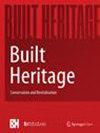Tianjin’s Italian-Style town: the conundrum between conservation practices and heritage value
Q1 Arts and Humanities
引用次数: 0
Abstract
The former Italian concession in Tianjin (1901–1945) has assumed symbolic significance for the modern urban redevelopment of this municipality through experimentation with distinctive practices of conservation management. In 1986, when the Historic Buildings Protection Area was defined, the former Italian concession was identified as a pilot urban conservation project. In 2002, the public company Haihe Construction and Development Investment Ltd. was put in charge of the design and implementation plan for the site, which progressively assumed the semblance of an ‘Italian-Style Town’. The distinctive transformation raised significant questions regarding the architectural restyling as well as its specific historical and cultural value. In August 2020, the management of the Italian-Style town was handed over to the Hebei District Government. This coincided with the emergence of a proposal for the creation of a ‘Larger Italian-Style Town’, that extended beyond the borders of the original Italian concession to include the former Austrian concession and the western section of the ex-Russian concession. The redevelopment strategy for this larger area aimed to create a service-oriented commercial area, presented as an ‘urban living room’, while showcasing Tianjin as an international metropolis. This article analyses the evolution of the conservation strategy as well as the relevant legislation, management, and practices during the redevelopment of the former Italian concession. The aim of this study is to address the conflict between heritage protection and commercialisation. Thus, this article offers a critique of the trend towards functional replacement and structural adaptation to cater to the tourism industry rather than to the value of the community’s livelihood as a living heritage.天津意大利风情小镇:保护实践与遗产价值之间的难题
天津的前意大利租界(1901-1945 年)通过尝试独特的保护管理做法,对该市的现代城市 重建具有象征意义。1986 年,在划定历史建筑保护区时,原意大利租界被确定为城市保护试点项目。2002 年,上市公司海河建设开发投资有限公司(Haihe Construction and Development Investment Ltd.)负责该地块的设计和实施计划,该地块逐渐呈现出 "意大利风情小镇 "的面貌。这一独具特色的改造引发了有关建筑风格重塑及其特定历史和文化价值的重大问题。2020 年 8 月,意大利风情小镇移交给河北区政府管理。与此同时,提出了创建 "大意大利风情小镇 "的建议,其范围超出了原意大利租借地的边界,包括前奥地利租借地和前俄罗斯租借地的西段。这一更大区域的重建战略旨在打造一个以服务为导向的商业区,作为一个 "城市客厅",同时展示天津作为国际大都市的形象。本文分析了前意大利租界重建过程中保护战略的演变以及相关立法、管理和实践。本研究旨在解决遗产保护与商业化之间的冲突。因此,本文对为迎合旅游业而不是作为活遗产的社区生计价值而进行功能替换和结构调整的趋势提出了批评。
本文章由计算机程序翻译,如有差异,请以英文原文为准。
求助全文
约1分钟内获得全文
求助全文

 求助内容:
求助内容: 应助结果提醒方式:
应助结果提醒方式:


